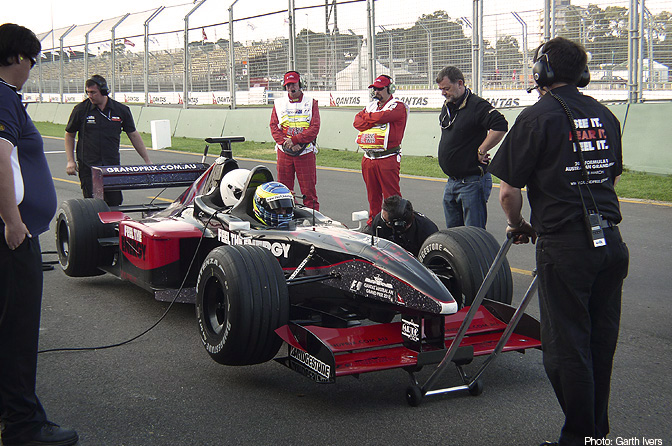

For the past couple of months I've been trying – without much success – to find a way of describing an experience that I will never, ever, forget. And, after many failed attempts at putting my thoughts into words, I've come to the conclusion that there simply isn't anything in the English language that illustrates what it's like to be strapped into a Formula 1 car.
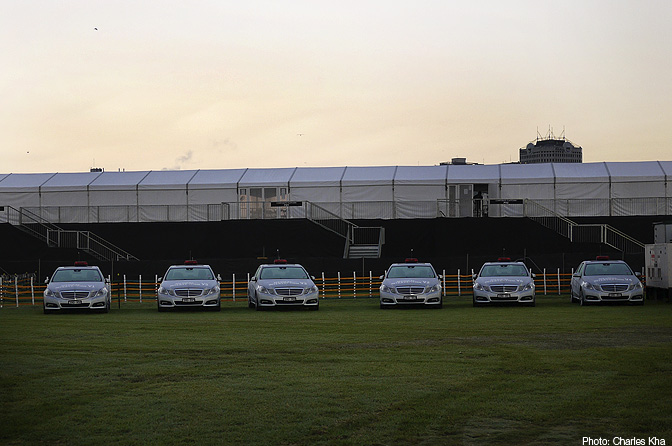
It's 6am, the Thursday before the Australian Grand Prix. I had been invited down to Melbourne to go for a ride in the Minardi two-seater F1 car and now that I'm here, in the inner-sanctum of F1's Paddock, the magnitude of what I'm about to experience starts to sink in. Around me, last minute construction work is being done to the Paddock Club hospitality suites, while the army of Mercedes-Benz safety cars lie dormant, covered in a film of morning frost.
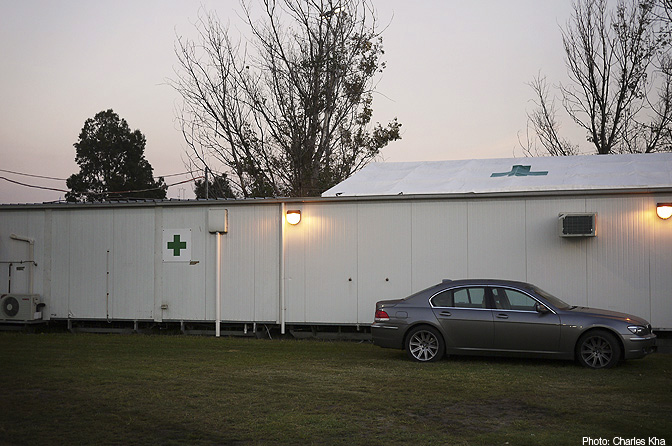
I've brought along the prerequisite medical certificates but I still have to undergo a medical examination by the FIA's Chief Doctor to ensure I'm physically fit enough to be put into the car. The Medical Center, which is a series of demountable structures, looks rather underwhelming in the high-tech world of F1. The picturesque location of Albert Park makes it easy to forget that this is a temporary street circuit set up once a year. Inside, the doctor hooks me up to some sort of beeping machine while he prods my belly and listens to my breathing. I'm told there are strict requirements to be a passenger in an F1 car. Candidates must have a clean bill of health, be under the age of 55, weigh no more than 88kg and be between 1.59m (5.2ft) and 1.8m (6ft) in height. For once I'm glad to be on the shorter end of the scale!
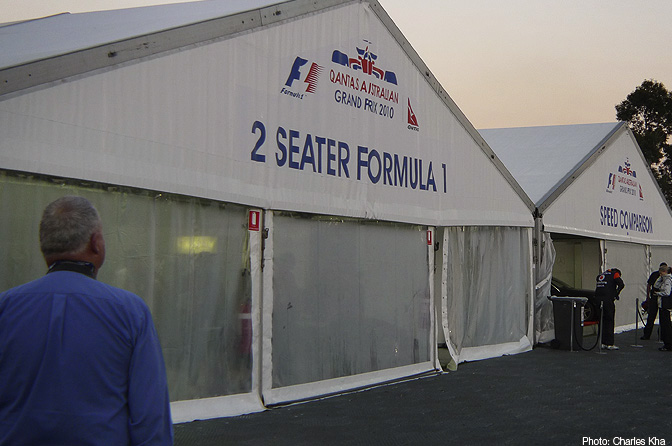
After a nervous fifteen minutes (at one point the machine I was hooked up to starting beeping crazily – thankfully it was a false alarm) the doctor gives me the thumbs up and I sign the first of many waiver forms. With the doc's approval I'm taken to the Support Paddock located behind the main pit garages. Here the Minardi team have set up camp alongside the various V8 Supercar teams.
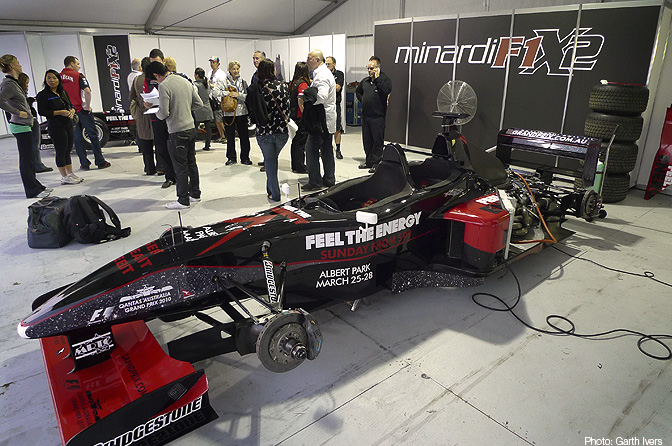
Inside the garage are two Minardi F1 cars. Both are real deal F1 racers that competed in GPs before being modified with an extended monocoque to accommodate a passenger behind the driver. In spite of the major modifications, these Minardis – which are known as F1x2s – have a dry weight of 545kg so they are the most accurate representation of what it's like in a real F1 car. Before I get the chance to look at the cars up close, another clipboard is thrust in front of me requiring me to acknowledge the dangers of what I'm about to take part in. To be honest, at that point I would have gladly signed anything because I'd be dying a happy man!
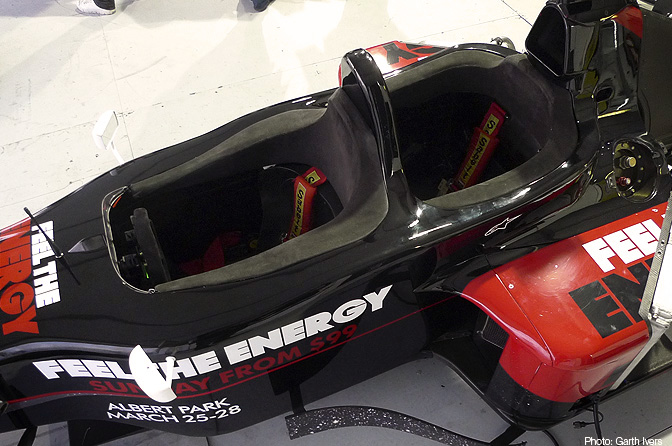
The thing that first strikes you when see a Formula 1 car in the flesh is just how low to the ground they are. Compared to a conventional F1 car, the F1x2 isn't that much longer (it comes in at 4870mm).
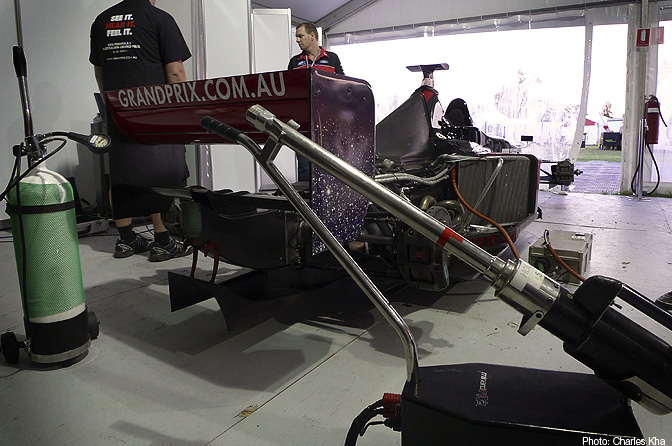
Without its wheels and engine cowl, it looks more like a fighter jet than a car. The F1x2 has a slightly extended wheelbase of 3370mm with a track of 1800mm.
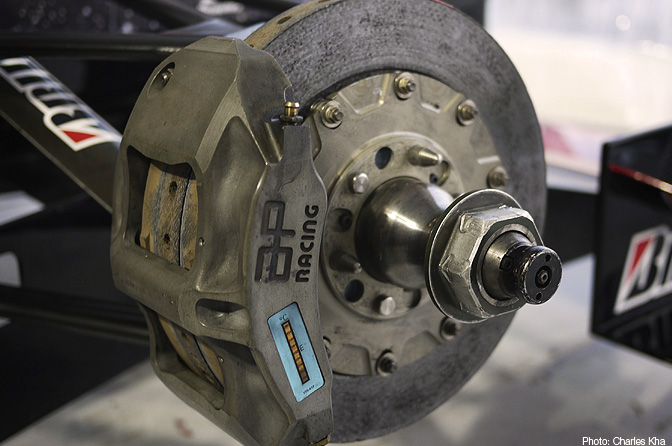
It's surprising how small an F1 car's brakes are. You'd think that brakes capable of generating 4g would be enormous in size, but they're small enough to fit behind a 13-inch rim. The Minardi uses 6-piston AP Racing calipers and inch-think carbon Hitco rotors.
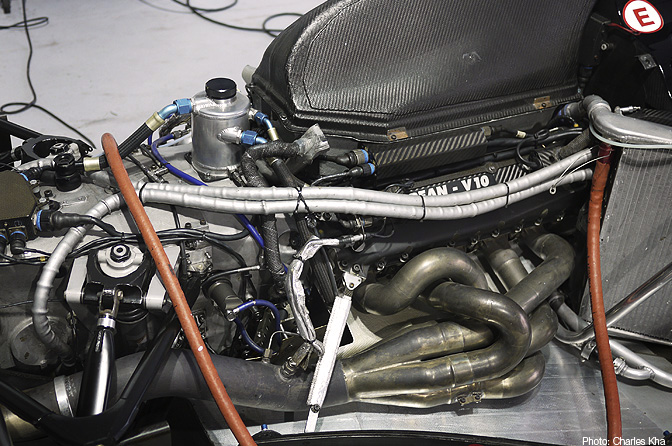
Here's the heart of the beast: a V10 built by Cosworth but re-badged under the European moniker. The crew weren't able to tell me an exact power figure, but it produces in excess of 700hp with the rev limit set to a 'conservative' 16,000rpm. As you can see, the engine is bolted directly to the monocoque, which is the safety cell that houses the occupants and the fuel tank. In an accident F1 cars are, quite literally, designed to disintegrate to dissipate energy away from the monocoque. Hmm, I really shouldn't be thinking about crashes when I'm about to get into an F1 car…
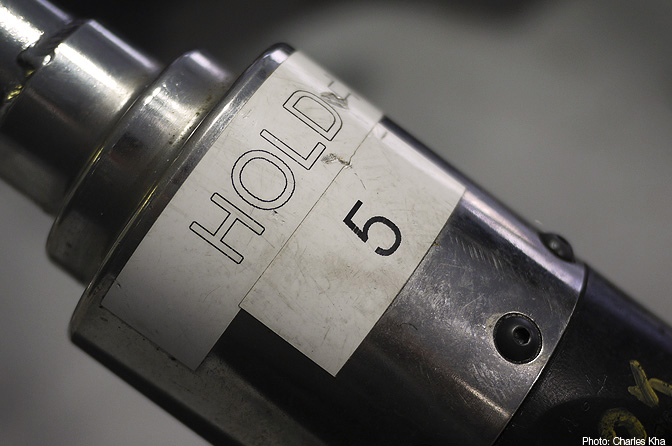
F1 engineers dedicate their lives to saving every gram of weight possible. There's a continual push for components to be lighter and smaller so the aerodynamics can be maximized. One thing that is sacrificed in F1 cars are onboard starter motors. Instead, F1 cars are fired up with an external starter motor, which is an enormous probe that is inserted into the rear end. Before anti-stall was permitted, F1 drivers had to rely on catching the motor with the clutch to prevent stalling.
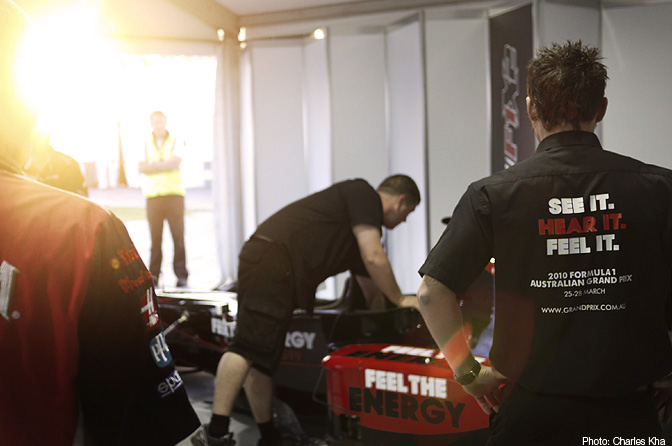
This dude's shirt summed up what I was about to experience. See it. Hear it. Feel it.
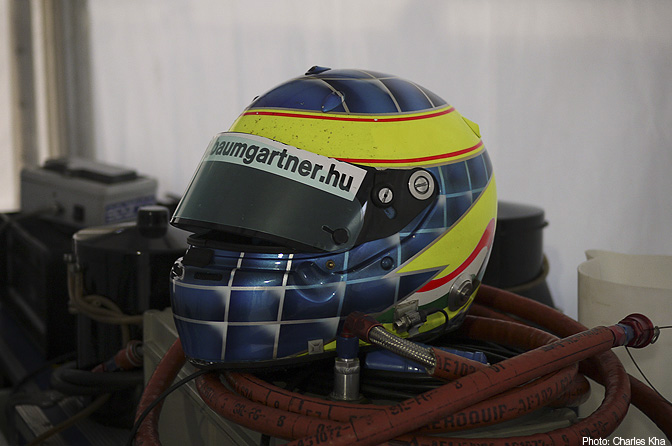
Two drivers were on duty, ex-F1 racer Zsolt Baumgartner and well-known Aussie driver Cameron McConville. No disrespect to Cam, but I really wanted Zsolt to be my driver, as no one has done more laps in the F1x2 than him. I also overheard Cam saying that after four laps in the F1 car his neck could no longer hold his head up!
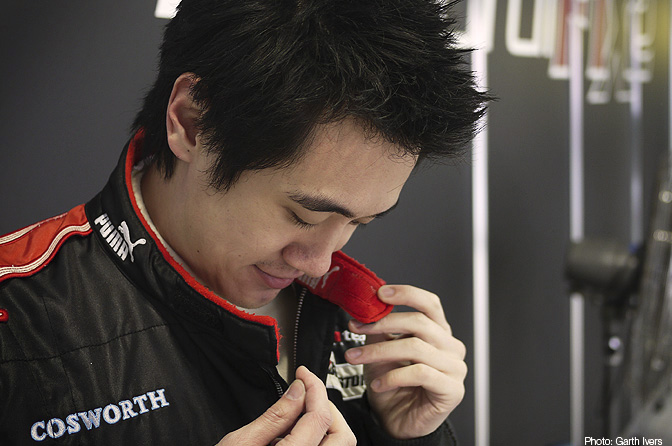
One by one we're measured and dressed in the appropriate attire. I'm told the importance of wearing the flame-proof apparel correctly: the flame-proof underwear needs to overlap, there can be no exposed skin whatsoever, and I should choose overalls that are a size too big (so the family jewels aren't crushed when I'm strapped in).
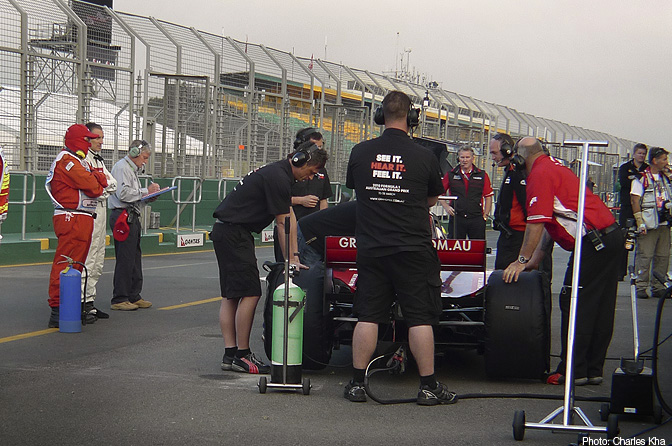
The F1x2 is pushed into the pit-lane, where the Minardi crew have set up a make-shift pit box. We'll each be given three laps in the F1x2: one out-lap, one flyer and one in-lap. I'm told I'll be the third passenger, with Zsolt as my driver.
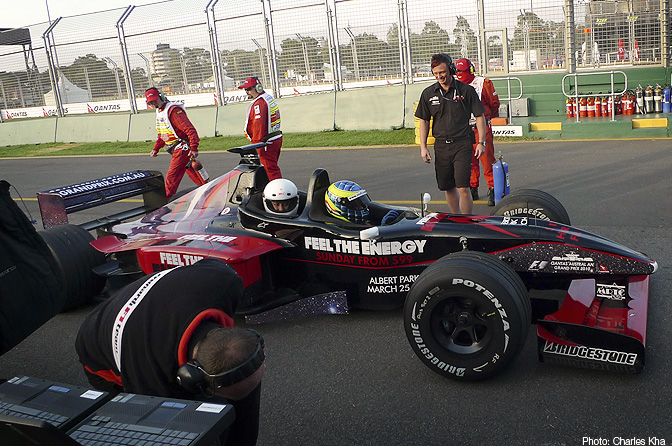
There are half a dozen people in my group, and the first to get a ride is Lydia Lassila who won gold in the recent Winter Olympics. Hearing a lone Formula 1 car screaming around the track, slicing through the still of the early morning, sent chills down my spine.
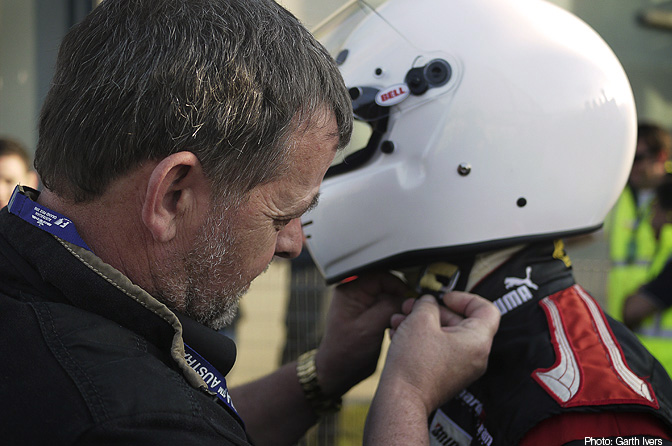
I'm a bit star-struck when Paul Stoddart, the millionaire owner of Minardi, gives me a warm handshake and helps put my helmet on. A lot has been said about Paul in the media, but within minutes of chatting to him you can't help but be impressed with how easy going he is. His passion for F1 is obvious, and there's a sense of regrettable irony that this F1 outcast is doing the most for the sport by giving us normal folk a chance to experience F1 first hand.
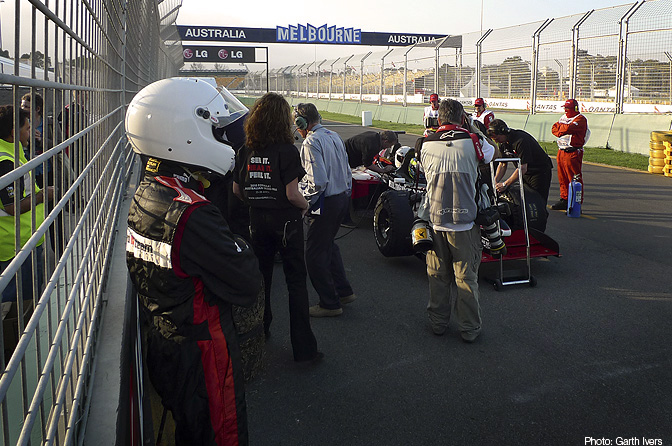
Although there's no pressure of competition, it's amazing to see how efficient the pit crew are. Everything is executed like clockwork, with the team working with military precision.
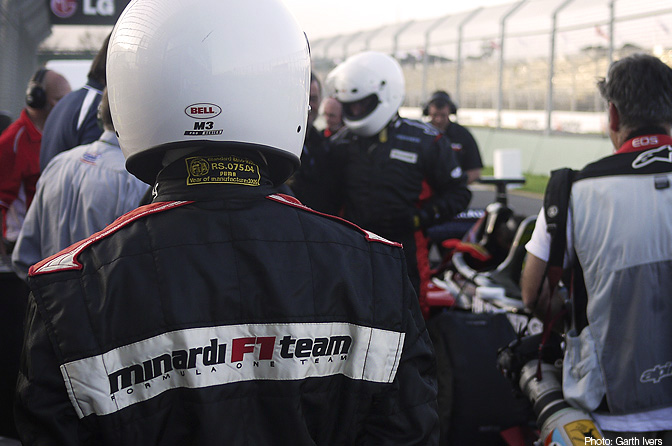
With a wink of the eye, Paul tells me it's my turn. Gulp.
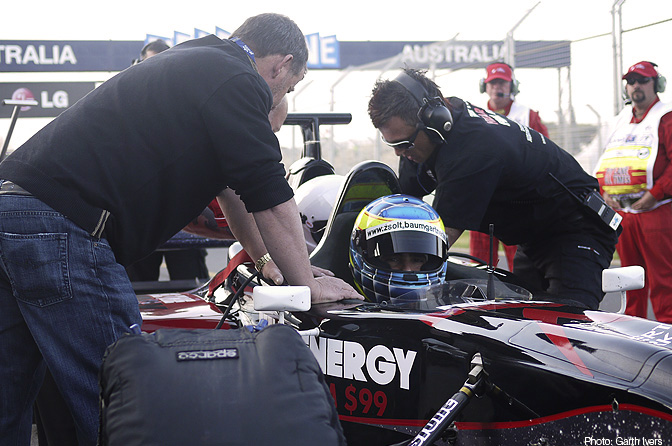
A custom stool – made of carbon fiber – is placed over the barge boards so I can step in without damaging any of the bodywork. It's a tiny opening, and getting in feels as if I'm lowering myself into a man-hole. My legs slide forward, straddling either side of the driver's seat. The cockpit is so small that Zsolt's seat is inches from my face, and I have to raise my arms so there's enough room for the mechanics to tighten the harness. I'm not a claustrophobic person, but as the cockpit surround is clipped into place it feels like I'm being buried alive.
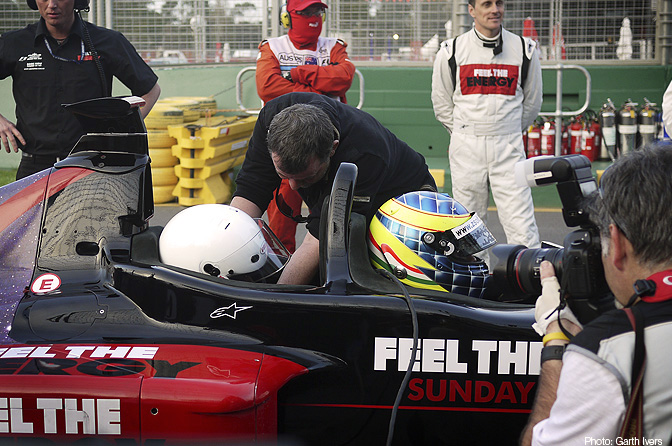
Before I have a chance to gather my thoughts and calm myself down, there's a heavy clunk from the rear as the starter motor is inserted. There's a sudden whirr from the starter that causes my teeth to chatter before the V10 barks into life, its idle a deep, menacing growl. I wince as the car is dropped off its jacks – your butt is literally on the floor so you feel everything – and without warning Zsolt selects a gear and releases the clutch. The F1x2 jolts forward like a train carriage and within a matter of meters we're glancing off the speed limiter. Brap-brap-brap-brap; the rev limit sends shockwaves through the chassis, my helmet bouncing against the headrest. We're hurtling down the pit lane with the garages flashing by to my right. Hey, this isn't too bad, I think to myself.
Now if there's one downside to the F1x2, it's the fact that you can't see what's directly in front of you. So there I was, thinking how tame an F1 car is, completely unaware that we were nearing the pit exit. I was mid-breath when Zsolt crossed the line and dropped the hammer, and what ensued was one of the scariest things I've ever experienced. The best way to describe it is to imagine being blind-folded and pushed in front of a speeding truck. The moment Zsolt released the limiter, my helmet snapped back and the air was sucked out of my lungs. I could feel the blood draining from my cheeks, my body frozen against the sudden acceleration. Just as I thought things couldn't get any worse, Zsolt hit the brakes for Turn 1 and everything went into reverse. My head was violently thrown forward, the visor of my helmet smashing against the back of his seat. I hate to say this, but for those first few seconds I was completely and utterly terrified. Although I had wanted to experience an F1 car since I was a child, the only thing I could think of was that I wanted to get out. I wanted it to stop. Immediately.
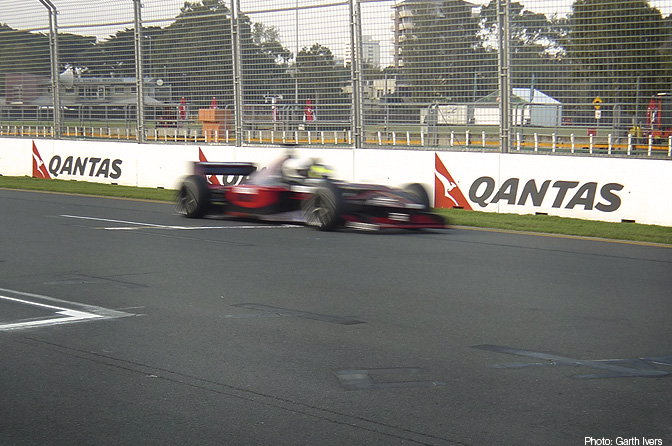
After a couple of corners the fear starts to subside and you try to get accustomed to not only the speed, but also the ferocity of it all. All of your senses are overwhelmed: your vision is a blur, your body is being battered and your ears are filled with the deafening scream of the V10.
When Zsolt stands on the brakes for Turn 9 I'm subjected to the full braking force of a Formula 1 car. The sudden increase in g-forces crush your body and it feels like my organs are being squished into my rib cage. Through the fast sweepers of 11 and 12 I'm thrown around like a rag doll. Although my belts were painfully tight, they've already worked loose and I'm completely helpless as I'm tossed right, left, right against the cockpit. Through the medium-speed corners I can feel the rear breaking away, the tyres groaning as Zsolt does a handful of micro-corrections – tiny flicks of opposite-lock – while staying on the throttle.
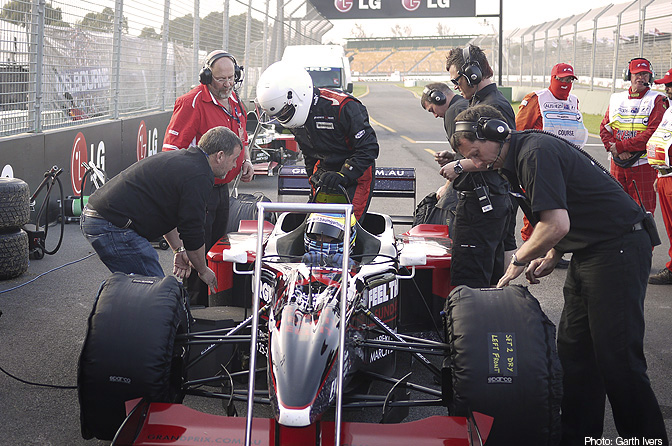
The second and third laps are exhilarating, but it's impossible to get used to the severity of the braking. On the main straight I took a peek around Zsolt, which proved to be a bad idea as the buffeting was so strong my helmet felt like it was going to be ripped off. And within five minutes, it's all over. I'm trembling when I get out of the car, and my elbows and knees are bruised from being banged against the cockpit.
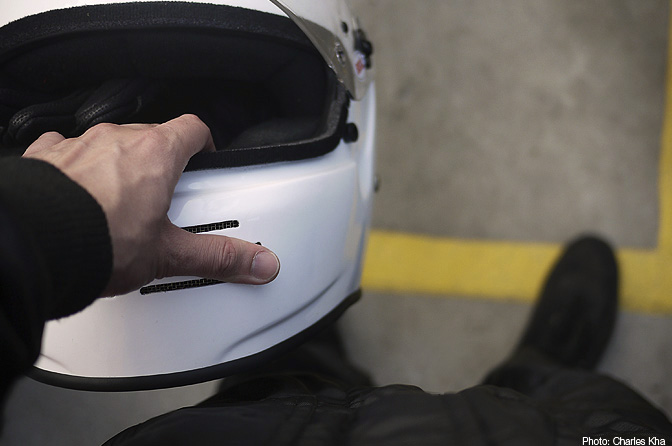
After just three laps I was completely exhausted – and I wasn't even driving. How F1 drivers can physically and mentally drive these things at 10/10ths for two hours is beyond comprehension. It's not the acceleration that separates Formula 1 from other racing categories, it's the staggering braking and extreme cornering speeds they are capable of. Was it an experience of a lifetime? Yes. Would I do it again? You bet. Was it enjoyable? Not in the slightest.
- Charles Kha








lol this is so funny. You did an excellent job with the vivid story. Damn, you're lucky to say you did something like that. forget bungie jumping lol
Hey Adam,
 He was an awesome host who didn't stop running around helping the passengers get in, tightening your harness, etc. Fantastic guy to chat to as well!
He was an awesome host who didn't stop running around helping the passengers get in, tightening your harness, etc. Fantastic guy to chat to as well!
Paul insisted on double-checking everyone's helmets
i really want to do this now... is there anyway normal people like me can do this?
I know Zsolt Baumgartner, he is Hungaryan. I was so said when he exit from the F1:'(
WOW!! Sounds like an amazing experience!!
Your body is now 5 years older. haha
it says "from $99" on the side of the car... how much was it to do this??? id pay $99 in a second to go for a ride in this
Awesome.
I. Hate. You.
Wow, what an experience
Charles, I am emotionally confused by you being able to ride in the 2 seater - not least of all because I know f1 infinitely more than you do. The fact that Stoddy had to kid strap you into the helmet said it all!
But... You... Lucky... *EXPLETIVE DELETIVE*
Great read ! I'm not a fan of F1 but i really would like to feel as Mr g-force sucker punches my face throughout the corners.
damn, now i want to experience this horror myself
I love the focus on that shot that Garth Ivers took when the car flew past. It really has a great impression of speed you know?
Excellent. Well written!
this is amazing
I took a ride in the exact same 2-seater about three years ago, and Charles, you are telling the story exactly right. The braking is the most astounding feeling by far - it feels like you're going to fly right out of the cockpit each time. The acceleration is amazing, but the braking followed by a multiple-G turn is something you simply cannot relate in words.
And I loved every second of it. After I got past those first 15 seconds of terror.
Looks totally nuts ! I think you did a good job writing this, i don't know if its accurate, but its sounds completely insanely wild !
I wanna do it too !
Great write-up... Thanks for sharing..
Ha ha! I've always loved motorsports and with internet follow it closer than ever, but you never get a good idea of what its like to be in the vehicles, until now. I'm jealous but would be more scared than Charles if it were me in that seat.
finally, a competent writer joins speedhunters
@ Adam Zillin: if you knew F1 infinitely more than Charles, maybe you'd know that its practically impossible to strap yourself into a F1 harness - even the current drivers have people strap them in... but whatever you say =/
Charles, you are one lucky guy... Can't wait till I move to Melbourne in a year or two!
That was great!! Really felt as I was in there (sort of)... Cool indeed !
nice writeup, but if you don't even know how to put on a helmet why the heck are you writing for a racing website again?
Good job Charles... this site just got a whole lot better.
"Was it enjoyable? Not in the slightest." LAWL!!!
Awesome write up! between the pictures and text i feel like ive just watched a video clip. 10/10
Do you remember the moment you climbed into the driver's seat for the very first time? The nervous excitement; the eagerness and trepidation as you twirled the key and heard the car bark into life? That's anxiety is kind of what I'm feeling
When the Speedhunters team was discussing the must-have inclusions for our Things to Do Before You Die